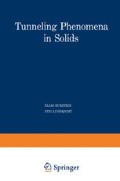Abstract
In Chapter 19 of this volume Giaever showed how tunneling has been used to understand the properties of superconductors and measure the energy gap. In Chapter 21 Schrieffer presents a very elegant picture of what happens in the tunneling experiment when we take an electron from one metal and inject it into a superconductor where it can exist as a quasiparticle above or below the Fermi momentum k F . In this case of metal-to-superconductor tunneling, at 0°K the derivative of the tunneling characteristic in the superconducting state (dI/dV) S , divided by that in the normal state, (dI/dV) N , is simply N(E)/N(0), where N(E) is the density of excited allowed states in the superconductor and N(0) that in the normal metal. In this chapter I further discuss the development of the tunneling technique as a tool in the study of superconductivity, and I want to make the following three claims and try to substantiate them:
-
1.
Tunneling is by far our most sensitive probe of the superconducting state.
-
2.
Using tunneling we believe we have confirmed that the present theory of superconductivity is accurate to a few per cent, i.e., if we know a number of properties of the normal metal, then we can calculate the superconducting properties (T c , H c versus T, Δ 0, the tunneling characteristic, etc.) to an accuracy of a few per cent. Unfortunately, our knowledge of these required normal-metal properties is generally not as extensive as that of the superconducting properties.
-
3.
Superconductivity, via an analysis of tunneling data, can tell us the normal-state properties mentioned in 2.
Access this chapter
Tax calculation will be finalised at checkout
Purchases are for personal use only
Preview
Unable to display preview. Download preview PDF.
References
P. W. Anderson, in: Proceedings VII International Conference on Low Temperature Physics, Toronto, 1960, Univ. of Toronto Press, 1961, p. 298.
I. Giaever, Ibid,p. 327.
I. Giaever, H. R. Hart, and K. Megerle, Phys. Rev. 126: 941 (1962).
P. Morel and P. W. Anderson, Phys. Rev. 125: 1263 (1962).
J. C. Swihart, IBM J. Res. Develop. 6: 14 (1962).
G. J. Culler, B. D. Fried, R. W. Huff, and J. R. Schrieffer, Phys. Rev. Letters 8: 399 (1962).
J. M. Rowell, A. G. Chynoweth, and D. E. Thomas, Phys. Rev. Letters 9: 59 (1962).
D. E. Thomas and J. M. Rowell, Rev. Sci. Instr. 36: 1301 (1965).
B. N. Brockhouse, T. Arase, G. Caglioti, K. R. Rao, and A. D. B. Woods, Phys. Rev. 128: 1099 (1962).
J. R. Schrieffer, D. J. Scalapino, and J. W. Wilkins, Phys. Rev. Letters 10: 336 (1963).
D. J. Scalapino, J. R. Schrieffer, and J. W. Wilkins, Phys. Rev. 148: 263 (1966).
D. J. Scalapino and P. W. Anderson, Phys. Rev. 133: A291 (1964).
J. C. Swihart, D. J. Scalapino, and Y. Wada, Phys. Rev. Letters 14: 106 (1965).
J. M. Rowell and L. Kopf, Phys. Rev. 137:907 (1965); J. G. Adler, J. S. Rogers, and S. B. Woods, Can. J. Phys. 43: 557 (1965).
W. L. McMillan and J. M. Rowell, Phys. Rev. Letters 14: 108 (1965).
W. L. McMillan and J. M. Rowell, in: Treatise on Superconductivity ( R. D. Parks, ed.), Marcel Dekker, New York, 1968.
R. F. Gasparovic, B. N. Taylor, and R. E. Eck, Solid State Commun. 4: 59 (1966).
C. K. Campbell, R. C. Dynes, and D. G. Walmsley, Can. J. Phys. 44:2601 (1966); C. K. Cambell and D. G. Walmsley, Can. J. Phys. 45: 159 (1967).
A. C. Thorsen, T. Wolfram, and L. E. Valby, Phys. Letters 25A: 548 (1967).
P. Kumbhare, P. M. Tedrow, and D. M. Lee, Bull. Am. Phys. Soc. 12: 77 (1967).
H. J. Levinstein, private communication.
J. G. Adler and J. E. Jackson, Rev. Sci. Inst. 37: 1049 (1966).
S. Bermon and D. M. Ginsberg, Phys. Rev. 135: A306 (1964).
Author information
Authors and Affiliations
Editor information
Editors and Affiliations
Rights and permissions
Copyright information
© 1969 Plenum Press
About this chapter
Cite this chapter
Rowell, J.M. (1969). Tunneling Density of States-Experiment. In: Burstein, E., Lundqvist, S. (eds) Tunneling Phenomena in Solids. Springer, Boston, MA. https://doi.org/10.1007/978-1-4684-1752-4_20
Download citation
DOI: https://doi.org/10.1007/978-1-4684-1752-4_20
Publisher Name: Springer, Boston, MA
Print ISBN: 978-1-4684-1754-8
Online ISBN: 978-1-4684-1752-4
eBook Packages: Springer Book Archive

